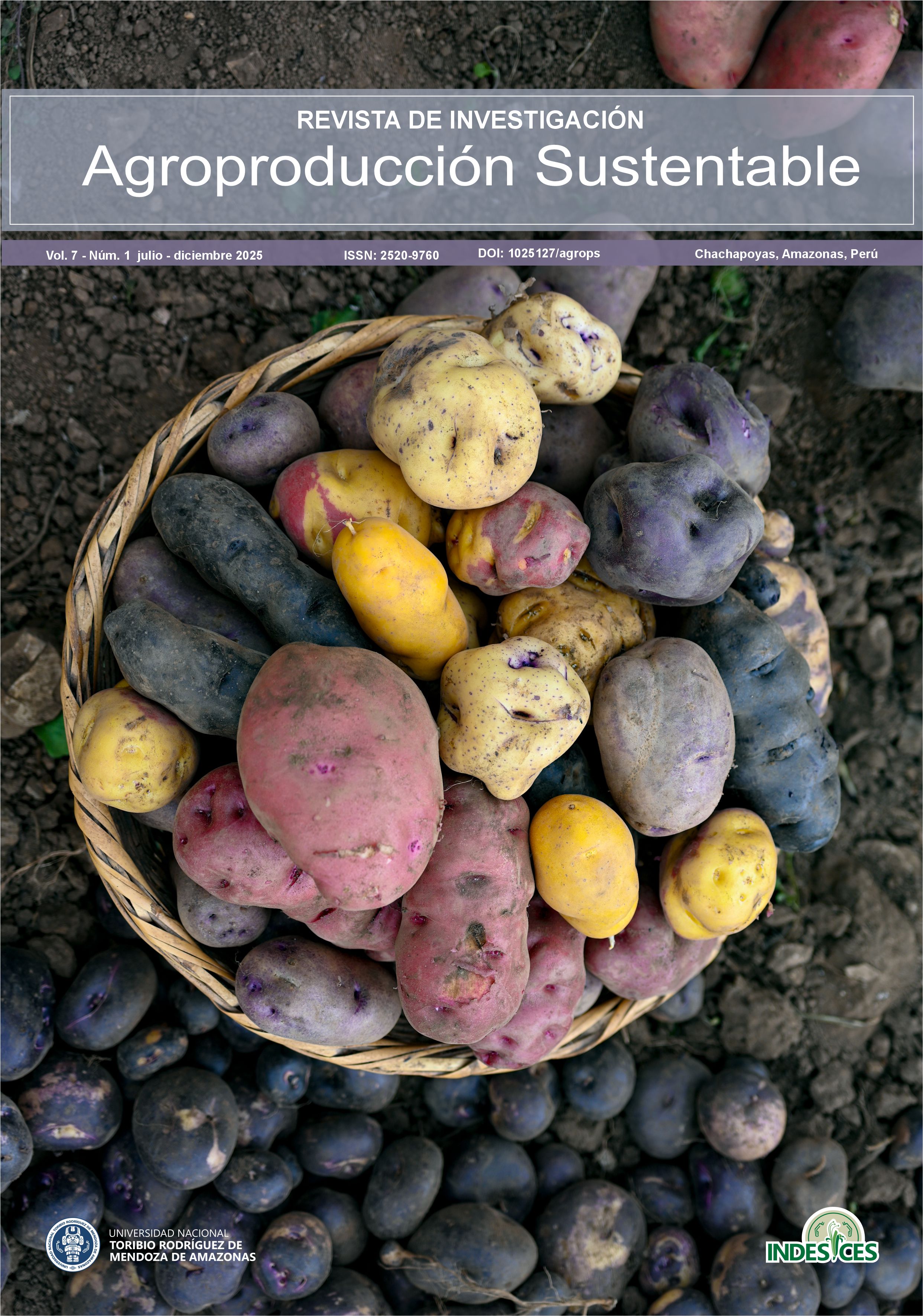Physicochemical and microbiological evaluation of anaerobically treated bovine rumen digestate for use as a biofertilizer
DOI:
https://doi.org/10.25127/agrops.20251.1138Keywords:
digestate, biofertilizer, agricultural systems, biosolAbstract
This study evaluated the physicochemical and microbiological characteristics of digestate produced by anaerobic digestion of bovine rumen content at the Chachapoyas Municipal Slaughterhouse (Peru) to determine its potential as a biofertilizer. Key effluent quality parameters, pH, turbidity, total solids, dissolved oxygen, nutrients, metals, and microbial indicators, were analyzed following Standard Methods for the Examination of Water and Wastewater. Results showed a substantial improvement in the physicochemical quality of the digestate, evidenced by a sharp reduction in turbidity (6620 to 770 NTU) and total solids (31,645 to 2,797 mg L⁻¹), along with an increase in dissolved oxygen (0.18 to 2.19 mg L⁻¹) and a near-neutral pH (6.74–6.86). Nitrites, sulfates, aluminum, iron, and barium concentrations decreased markedly, while potassium and magnesium increased, reinforcing the digestate’s agronomic potential as a nutrient-rich biofertilizer. Conversely, the microbiological analysis revealed persistent contamination by total and fecal coliforms, as well as Escherichia coli (1.52 × 10⁶ MPN/100 mL), although Salmonella spp. and Vibrio cholerae were not detected. These findings indicate that while anaerobic digestion enhances the physicochemical stability and nutrient composition of the digestate, it does not ensure microbiological safety. Post-digestion treatments, such as composting, pasteurization, or biochar adsorption, are recommended to ensure safe agricultural application within sustainable production systems.Downloads
Published
Issue
Section
License
Copyright (c) 2025 Mariños López-Mas, Wildor Gosgot-Angeles, Homar Santillan-Gomez, Merbelita Yalta-Chappa, Miguel Barrena-Gurbillón

This work is licensed under a Creative Commons Attribution-NonCommercial-ShareAlike 4.0 International License.
Aquellos autores/as que tengan publicaciones con esta revista, aceptan los términos siguientes:
- Los autores/as conservarán sus derechos de autor y garantizarán a la revista el derecho de primera publicación de su obra, el cuál estará simultáneamente sujeto a la Licencia de reconocimiento de Creative Commons. Por tanto:
Usted es libre de:
- Compartir — copiar y redistribuir el material en cualquier medio o formato
- Adaptar — remezclar, transformar y construir a partir del material
- La licenciante no puede revocar estas libertades en tanto usted siga los términos de la licencia
Bajo los siguientes términos:
Atribución — Usted debe dar crédito de manera adecuada, brindar un enlace a la licencia, e indicar si se han realizado cambios. Puede hacerlo en cualquier forma razonable, pero no de forma tal que sugiera que usted o su uso tienen el apoyo de la licenciante.
NoComercial — Usted no puede hacer uso del material con propósitos comerciales.
CompartirIgual — Si remezcla, transforma o crea a partir del material, debe distribuir su contribución bajo la lamisma licencia del original.
- No hay restricciones adicionales — No puede aplicar términos legales ni medidas tecnológicas que restrinjan legalmente a otras a hacer cualquier uso permitido por la licencia.
- Los autores/as podrán adoptar otros acuerdos de licencia no exclusiva de distribución de la versión de la obra publicada (p. ej.: depositarla en un archivo telemático institucional o publicarla en un volumen monográfico) siempre que se indique la publicación inicial en esta revista.
- Se permite y recomienda a los autores/as difundir su obra a través de Internet (p. ej.: en archivos telemáticos institucionales o en su página web) antes y durante el proceso de envío, lo cual puede producir intercambios interesantes y aumentar las citas de la obra publicada. (Véase El efecto del acceso abierto).

Esta obra está bajo una Licencia Creative Commons Atribución-NoComercial-CompartirIgual 4.0 Internacional


